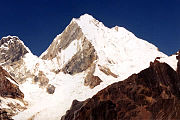- Cordillera Huayhuash
-
Cordillera Huayhuash Range YerupajáCountry Peru Regions Ancash Region, Huanuco Region Part of Andes Highest point Yerupajá - elevation 6,635 m (21,768 ft) - coordinates 10°16′S 76°54′W / 10.267°S 76.9°W The Cordillera Huayhuash is a mountain range in the Andes of Peru. It is located in the boundaries of the Ancash Region, Lima Region, y Huanuco Region. There are several lakes there including Soltera Cocha, Jahuacocha, Carhuacocha and Sarapococha.
The range is 30 km long and has Himalayan characteristics and its peaks are, morphologically speaking, much more hilly and have more difficult access than those from the Cordillera Blanca. Aligned north to south, the main range of some twenty peaks stretches for approximately 25 km, with a subsidiary range of smaller peaks stretching out to the west for approximately 15 km. Six of the peaks exceed 6000 m. Included among them are Yerupajá (6617 m), the second highest mountain in Peru (behind Huascarán at 6768 m), and Siula Grande (6344 m), made famous by Joe Simpson in Touching the Void.
There are many lesser peaks surrounding those covered by ice, and several passes exceeding 5000 m. It is necessary to travel a considerable distance from the central range to find ground lower than 3000 m, even on valley floors, and the Cordillera Huayhuash is often taken to include this much larger area. The vegetated areas of the range are part of the Central Andean wet puna ecoregion[1]
The area is barely populated at all, with what hamlets there are being very small and generally only found below 4000 m (the snowline is found at approximately 4800 m). The nearest villages are Chiquián (3400 m) and Cajatambo (3375 m). Some mining takes place in the area, so to the north of the mountains there is an unsurfaced road leading up to as high as 4750 m. In 2002 the Peruvian Ministry of Agriculture declared the Huayhuash a "reserved zone" and prohibited certain economic activities, including any future mining.
Some of the mountains located in the Huayhuash are Yerupajá (6635 m), Jirishanca (6126 m), Siula Grande (6356 m), Sarapo (6143 m) and Rondor (5883 m).
Contents
Trekking
The range has become noted for trekking in the form of the Huayhuash Circuit, which is considered quite a challenge and is undoubtedly far more demanding than the famous Inca Trail in the south of Peru. Fewer people trek the Huayhuash than the nearby Cordillera Blanca. The circuit generally takes between ten and fourteen days, depending on the route taken.
Most of the walking, and most of the campsites, are above the 4000 m tree line, so the landscape appears rugged and mountainous, affording views over very wide areas. The area is noted for its spectacular glacial lakes. Hot springs can also be found in the area. Condors, llamas, alpacas and viscachas can be seen. Trekking is almost always undertaken in the dry winter months of May to September, and the cities of Huaraz and Caraz over 100 & 167 km away are the usual choice for organizing and hiring camping a/o logistical support. Chiquián was for a long time the "Gateway to the Huayhuash" but nowadays, daily colectivos go deep into the mountains to the village of Llamac (3300 m) and with private transport, as far as Cuartelhain camp, reached both by road built in the late 90s and 2000s, becoming now the new trail heads for starting/ending.
Safety
Until the group's effective defeat in 1992 the Cordillera Huayhuash was used as a remote base by the Shining Path. On July 28, 1988, a group of Canadian and Peruvian climbers were held hostage for 12 hours after a failed assassination attempt on a group of military police. None of the climbers or police were hurt, though one Senderista was killed. In the late 1980s a party of European trekkers were robbed and ordered to return to Huaraz with the message that future intruders would be killed. The remains of a guerrilla camp can be seen near Laguna Viconga.
Two foreign trekkers are known to have been murdered in Cajatambo in August 2002, though this is thought to have been motivated by robbery. Four hikers who resisted armed robbery were shot in 2004, one dying of blood loss before rescue. Since this last incident, the local communities began to charge a "protection" fee for passing in the private properties. Since then, the area is considered generally safe.
Near the north shore of Laguna Viconga, the remains of an old Sendero Luninoso base camp can be still visited, including a shooting range, barracks and a training field.
List of notable peaks
Only named peaks are included in this list. Most names are of Quechua origin.
Primary range
North to south:
- Ninashanca (5607 m)
- Rondoy (5870 m)
- Mitaraju (5750 m)
- Jirishanca Chico (5446 m)
- Jirishanca (6094 m)
- Yerupaja Chico (6089 m)
- El Toro (5830 m)
- Yerupaja (6617 m)
- Siula Grande (6344 m)
- Seria Punta (5567 m)
- Sarapo (6127 m)
- Sarapococha (5370 m)
- Carnicero (5960 m)
- Nevada Suerococha (5625 m)
- Nevada Jurau (5674 m)
- Nevada Huaraca (5537 m)
- Nevada Quesillo (5600 m)
- Trepecio (5653 m)
- Sueroraju (5439 m)
- Cuyoc (5550 m)
Subsidiary range
East to west:
- Seria Norte (5860 m)
- Seria (5543 m)
- Seria Sur (5230 m)
- Rasac (6040 m)
- Tsacra Chico (5548 m)
- Tsacra Grande (5774 m)
- Huacrish (5622 m)
- Ancocancha Este (5557 m)
- Ancocancha (5560 m)
- Nevada Suerococha (5350 m)
References
- ^ Olson, D. M, E. Dinerstein, et al (2001). "Terrestrial Ecoregions of the World: A New Map of Life on Earth". BioScience 51 (11): 933–938. doi:10.1641/0006-3568(2001)051[0933:TEOTWA]2.0.CO;2. http://gis.wwfus.org/wildfinder/.
External links
Categories:- Mountain ranges of Peru
Wikimedia Foundation. 2010.





